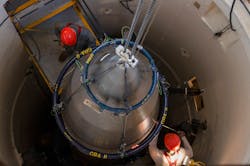Johns Hopkins to provide research effort to design GBSD ballistic missile as Minuteman III replacement
HILL AIR FORCE BASE, Utah – U.S. Air Force strategic weapons experts are choosing John Hopkins University to provide research support for the next-generation U.S. intercontinental ballistic missile (ICBM) to replace the Minuteman III under terms of a 10-year contract announced Monday worth more than half a billion dollars.
Officials of the Air Force Nuclear Weapons Center at Hill Air Force Base, Utah, are asking experts from the Johns Hopkins Applied Physics Laboratory for research and development services in support of the nuclear enterprise in a $530 million contract, as well as for research to support the Ground Based Strategic Deterrent (GBSD) weapon system, which will replace Minuteman III, in a $23.7 million order.
The GBSD missile is the follow-on to the aging LGM-30G Minuteman III ICBM and first became operational in 1970. The GBSD ICBM will have increased accuracy, enhanced security, and improved reliability.
These contracts provide research and development services in support of the two intercontinental ballistic missile systems. The Northrop Grumman Corp. Strategic Deterrent Systems division in Roy, Utah., won a $13.3 billion contract last September to design and build the GBSD.
The Northrop Grumman GBSD team includes Aerojet Rocketdyne in El Segundo, Calif.; Bechtel Corp. in Reston, Va.; Clark Construction Group in Bethesda, Md.; the Collins Aerospace segment of Raytheon Technologies Corp. in Cedar Rapids, Iowa; General Dynamics Corp. in Reston, Va.; HDT Global Inc. in Solon, Ohio; Honeywell International Inc. in Charlotte, N.C.; Kratos Defense and Security Solutions Inc. in San Diego; L3Harris Technologies in Melbourne, Fla.; Lockheed Martin Corp. in Bethesda, Md.; and Textron Systems in Providence, R.I.
Also on the Northrop Grumman GBSD team are hundreds of small- and medium-sized companies from across the defense, engineering, and construction industries, Northrop Grumman officials say.
The GBSD design effort as a Minuteman III replacement will take 8.5 years and include weapon system design, qualification, test and evaluation, and nuclear certification, Northrop Grumman officials say. The Air Force wants the new missile to be operational by 2029.
The GBSD will have a 300-kiloton W87 Mod 0 thermonuclear warhead of unknown yield, capable of air- or ground-burst detonation. The silo-launched missile will have three-stage solid-fuel rocket propulsion with inertial and GPUS guidance.
The GBSD will replace the U.S. Minuteman III fleet at 450 missile sites in Colorado, Montana, Nebraska, North Dakota, and Wyoming. The missiles themselves are in underground silos and are ready for launch on very short notice. ICBMs constitute one-third of the nation's nuclear weapons deterrent. Other U.S nuclear warheads are on submarine-launched ballistic missiles and on manned jet bombers.
Each Minuteman III missile is 60 feet tall, 5.5 feet in diameter, and powered by three solid rocket motors that can launch the 80,000-pound missile to altitudes of 700 miles to deliver nuclear warheads as far away as 6,500 miles. Each missile contains as many as three independently targeted warheads in separate reentry vehicles.
The Minuteman III originally was equipped with a Rockwell Autonetics D37D flight computer, but as of 2008 had been upgraded as part of the Minuteman-III Guidance Replacement Program (GRP).
On the GBSD research support contract Johns Hopkins will do the work in Laurel, Md., and should be finished by July 2031. For more information contact the John Hopkins Applied Physics Laboratory online at www.jhuapl.edu, or the Air Force Nuclear Weapons Center at www.afnwc.af.mil.

John Keller | Editor-in-Chief
John Keller is the Editor-in-Chief, Military & Aerospace Electronics Magazine--provides extensive coverage and analysis of enabling electronics and optoelectronic technologies in military, space and commercial aviation applications. John has been a member of the Military & Aerospace Electronics staff since 1989 and chief editor since 1995.

